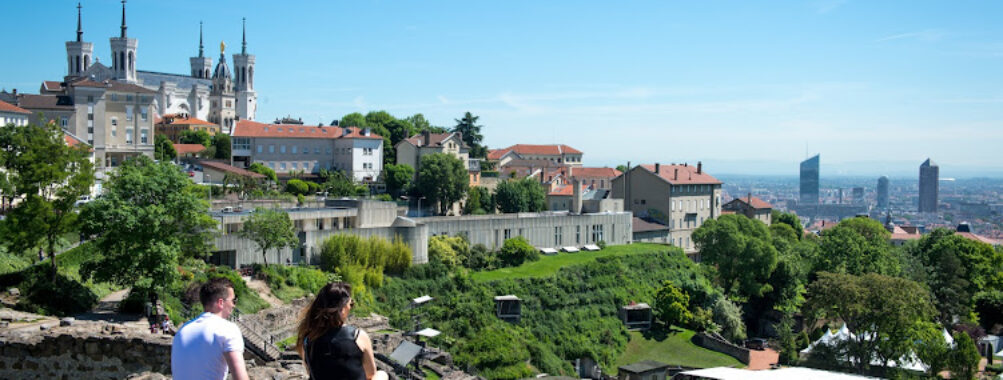
Gallo-Roman Museum of Lyon-Fourvière
Table of Contents
Description
The Gallo-Roman Museum of Lyon-Fourvière, also known simply as Lugdunum, is one of those places that manages to feel both ancient and strikingly modern at the same time. Built right into the hillside of Fourvière, the museum overlooks the Rhône and Saône rivers and sits just beside Lyon’s Roman theatres. It’s not just a museum where you walk past dusty relics and move on—this one feels alive, like you’re stepping into the daily rhythm of a Roman city that thrived nearly two thousand years ago. From mosaics that still shimmer with color to coins that once jingled in the pockets of merchants, every object tells a story about life in what was once the capital of Roman Gaul.
What makes this museum particularly special is its design. Instead of a flashy building that competes with the ruins, the structure is tucked into the hillside, almost hidden. Inside, the concrete walls and wide spaces give off a timeless vibe—some might say a little brutalist, but it works. The atmosphere is quiet and contemplative, allowing you to focus on the artifacts themselves. And while most visitors leave impressed, there are a few who might find the layout a bit confusing or the signage not as detailed as they’d like. Still, the overwhelming majority walk out with a sense of awe at just how much Roman history is preserved here.
Key Features
- Extensive collection of Roman mosaics, including the famous Circus Games mosaic from the 2nd century.
- Artifacts ranging from pottery, coins, and jewelry to monumental sculptures and inscriptions.
- Direct connection to Lyon’s Roman theatres, making it easy to pair a museum visit with a stroll among the ruins.
- Interactive displays and reconstructions that help bring the Roman city of Lugdunum to life.
- Occasional live performances and cultural events staged in the nearby theatres.
- Wheelchair accessible facilities including entrances, restrooms, and parking.
- Family-friendly environment with exhibits that capture the attention of children as well as adults.
Best Time to Visit
If you want to avoid the crowds, weekdays in the late morning or early afternoon are usually the calmest. Summer can be busy, especially when the outdoor theatres host performances, but that adds a unique energy to the whole site. Personally, I think spring and autumn are the sweet spots. The weather is mild, the Fourvière hill is lush with greenery, and you won’t feel rushed moving through the exhibits. Winter has its charm too—fewer visitors, a quieter atmosphere, and you get to enjoy the museum almost like it’s your own private time capsule. Just keep in mind that Lyon can get chilly, so bring a good coat if you plan to wander the ruins outside.
How to Get There
Reaching the museum is part of the adventure. It’s perched on Fourvière hill, which means you’ll either climb a bit (and trust me, your calves will feel it) or you’ll take the funicular from Vieux Lyon. The funicular ride itself is a fun experience, especially if you’re traveling with kids. Once you’re up there, it’s just a short walk to the museum entrance. Public transport is reliable, and for those who prefer driving, there’s accessible parking close by. If you’re staying near the old town, you can even walk—it’s uphill, but the views along the way are worth the effort. I once made the trek on foot with a baguette in hand, and while I regretted the crumbs in my bag, I didn’t regret the view at the top.
Tips for Visiting
Here are a few things I wish I had known before my first visit. First, give yourself plenty of time. Two hours is the bare minimum if you want to see the highlights, but three or four hours lets you linger and really soak it all in. Bring water, especially if you plan to explore the outdoor theatres afterward. The museum doesn’t have a restaurant, so grab a snack before you go or plan to eat afterward in the city center. Comfortable shoes are a must—the terrain outside is uneven, and inside the museum you’ll be doing a fair amount of walking.
Photography is allowed, and the mosaics are incredibly photogenic, but don’t spend the whole time behind your camera. Stand in front of the Circus Games mosaic and just imagine the noise of the arena—it’s an experience you can’t capture in a photo. Families will be happy to know it’s kid-friendly, with plenty of objects that spark curiosity, like ancient toys and coins. Accessibility is well thought out, so visitors with mobility needs won’t struggle. And if you can, try to catch one of the live performances in the Roman theatres nearby. Watching a play or concert in the same spot where Romans once gathered is the kind of memory that sticks with you long after you’ve left Lyon.
In short, the Gallo-Roman Museum of Lyon-Fourvière isn’t just another stop on a sightseeing list. It’s a place where history feels tangible, where you can connect with a city that has been reinventing itself for centuries. Whether you’re a history buff, a casual traveler, or someone just looking to escape the bustle of the city for a few hours, this museum offers a window into a world that continues to shape Lyon’s identity today.
Location
Places to Stay Near Gallo-Roman Museum of Lyon-Fourvière
Find and Book a Tour
Explore More Travel Guides
No reviews found! Be the first to review!